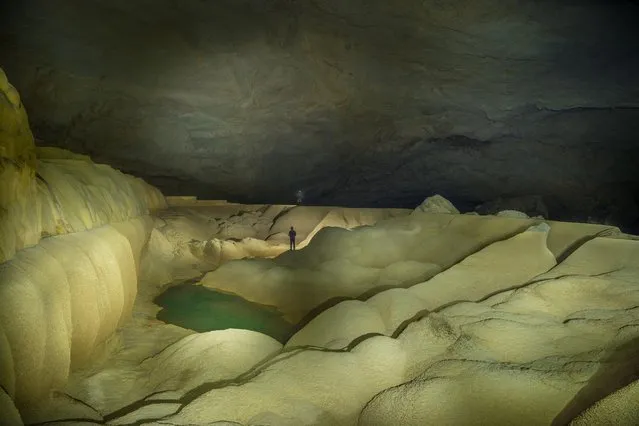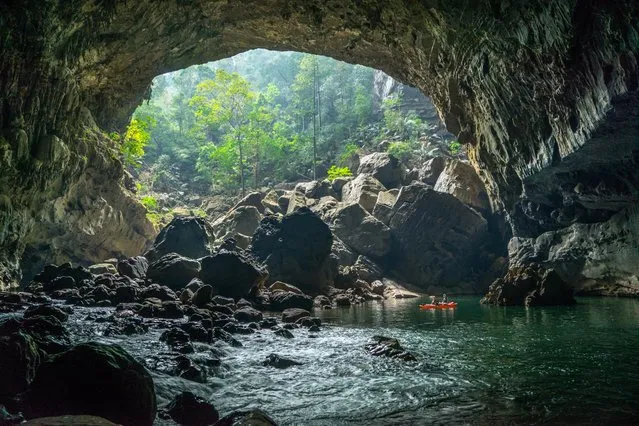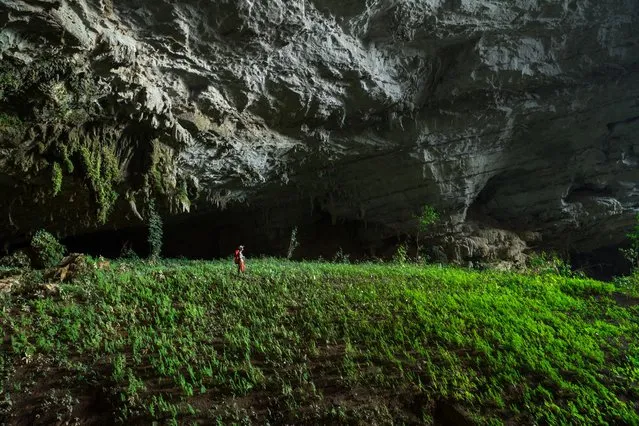
Floating on clear deep water and reflections near the cave entrance. Visitors can either bring their own kayaks or rent boats from the local community to paddle deep inside the cave and marvel at its wonders on March 2015 at Tham Khoun Ex, Laos. Tham Khoun Xe, commonly known as the Xe Bang Fai River Cave, in Laos, has over 15km of passages filled with awe-inspiring views and wide expanses of water. Photographer, John Spies, 59, captured scenes from the entrances of the huge underground river passages, intricate cave formations and views from a passage high above the water. The cave is formed by the Xe Bang Fai river, a major tributary of the Mekong and in the dry season can be traversed using inflatable kayaks. (Photo by John Spies/Barcroft Media/ABACAPress)

Water painting with kayaks and submerged LED lights near the downstream entrance of the cave on March 2015 at Tham Khoun Ex, Laos. (Photo by John Spies/Barcroft Media/ABACAPress)

Massive formations abound in a newly discovered fossil section of the cave, 50 meters above the river level. This section, encrusted with delicate formations and not yet open to tourists, is one of several higher passages that lead to jungle shrouded entrances on March 2015 at Tham Khoun Ex, Laos. (Photo by John Spies/Barcroft Media/ABACAPress)

Water painting with kayaks and submerged LED lights near the downstream entrance of the cave. on March 2015 at Tham Khoun Ex, Laos. (Photo by John Spies/Barcroft Media/ABACAPress)

Massive formations abound in a newly discovered fossil section of the cave, 50 meters above the river level. This section, encrusted with delicate formations and not yet open to tourists, is one of several higher passages that lead to jungle shrouded entrances. on March 2015 at Tham Khoun Ex, Laos. (Photo by John Spies/Barcroft Media/ABACAPress)

The Giant Gour in the Oxbow area of the cave is 60 meters long and is probably one of the world?s largest rimstone basins. The pool is filled with water during the wet season. The rims of basins like this grow taller each year as calcite precipitates from cave water as it flows faster over protrusions on March 2015 at Tham Khoun Ex, Laos. (Photo by John Spies/Barcroft Media/ABACAPress)

A blue-tinted glow from outside illuminates the entrance chamber of the cave on March 2015 at Tham Khoun Ex, Laos. (Photo by John Spies/Barcroft Media/ABACAPress)

The immense proportions of Tham Khuon Xe, one of the world's greatest river caves, are difficult to photograph. A team of 4 equipped with powerful LED lights and walkie-talkies managed to light-paint this enormous section for this long exposure shot on March 2015 at Tham Khoun Ex, Laos. (Photo by John Spies/Barcroft Media/ABACAPress)

A cave explorer amongst giant stalagmites in the Stairway to Heaven area of the cave on March 2015 at Tham Khoun Ex, Laos. (Photo by John Spies/Barcroft Media/ABACAPress)

Sunlight streams into the mist-filled fossil passage near the sink of the Xe Bang Fai River. This section supports a verdant garden of ferns and other low light plants on March 2015 at Tham Khoun Ex, Laos. (Photo by John Spies/Barcroft Media/ABACAPress)

The subterranean passage of the river is spectacularly decorated with calcified formations.on March 2015 at Tham Khoun Ex, Laos. (Photo by John Spies/Barcroft Media/ABACAPress)

The upstream inflow entrance of Tham Khoun Xe has a verdant forest inside a huge collapsed doline. It is possible to kayak from the resurgence to here and back in one full day. There are several more kilometers of cave in an adjacent fossil passage that visitors can access by climbing the boulder pile. on March 2015 at Tham Khoun Ex, Laos. (Photo by John Spies/Barcroft Media/ABACAPress)

Enormous banks of terraced flowstone decorate the walls of the cave in many places. This slowly growing mound of white and orange calcite is one of the larger deposits along the river passage on March 2015 at Tham Khoun Ex, Laos. (Photo by John Spies/Barcroft Media/ABACAPress)

The Giant Gour in the Oxbow area of the cave is 60 meters long and is probably one of the world's largest rimstone basins. The pool is filled with water during the wet season. The rims of basins like this grow taller each year as calcite precipitates from cave water as it flows faster over protrusions on March 2015 at Tham Khoun Ex, Laos. (Photo by John Spies/Barcroft Media/ABACAPress)

American cave explorer Dave Pierce marvels at giant cave pearls, some with a hexagonal shape, in the “Oxbow” section of the cave. These may well be the largest known examples on earth. Cave pearls grow like pearls in an oyster with concentric layers of calcite slowly building up year after year on March 2015 at Tham Khoun Ex, Laos. (Photo by John Spies/Barcroft Media/ABACAPress)

Heading into darkness, a visitor paddles a small canoe near the downstream entrance. In the dry season from November to April, the only part of the year safe to visit the cave, the water is clear and deep with a rich green hue on March 2015 at Tham Khoun Ex, Laos. (Photo by John Spies/Barcroft Media/ABACAPress)

Visitors to Tham Khuon Xe can rent canoes or kayaks and paddle upstream to view the stunning calcifications on the cave walls on March 2015 at Tham Khoun Ex, Laos. (Photo by John Spies/Barcroft Media/ABACAPress)

Suphaporn Singnakphum stands amongst lush low-light plants in an underground garden in a huge fossil passage that adjoins the inflow entrance of Tham Khuon Xe on March 2015 at Tham Khoun Ex, Laos. (Photo by John Spies/Barcroft Media/ABACAPress)

Suphaporn Singnakphum stands amongst lush low-light plants in an underground garden in a huge fossil passage that adjoins the inflow entrance of Tham Khuon Xe on March 2015 at Tham Khoun Ex, Laos. (Photo by John Spies/Barcroft Media/ABACAPress)
11 Apr 2015 09:56:00,
post received
0 comments
